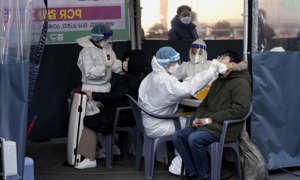Feb. 23 (UPI) -- A new, potentially more contagious and threatening strain of Omicron, BA.2, is spreading in the United States and may threaten efforts to relax COVID-19 pandemic-related restrictions across the country.

The strain already has led to a rapid increase in cases in Denmark, which moved to relax pandemic restrictions in recent days, according to the World Health Organization. Brunei, Georgia and Nepal also are experiencing significant outbreaks.
And while the numbers in the United States are small, medical detectives are keeping a close watch on trends.
Fewer than 1,400 cases involving the new subvariant have been reported in this country, according to outbreak.info, which is supported by the Centers for Disease Control and Prevention and other major research groups. That's less than 0.5% of cases reported since BA.2 appeared.
The subvariant has been reported in every state except Iowa, Main and Oklahoma. California has had the largest number of documented cases, 262.
Dubbed the "stealth variant" because it appears to be more difficult to detect than earlier strains of the virus that causes COVID-19, BA.2 has been found to be more transmissible and perhaps less responsive to vaccines and treatments than its predecessors, WHO says.
"There's not a lot of information that we have on this particular subvariant yet," Maria Van Kerkhove, WHO technical lead on COVID-19, said during a press conference earlier this month.
However, "because it is part of this package of Omicron, we do know obviously that there is increased growth rate compared to other variants of concern," she said.
Increased transmission
As the surge in COVID-19 cases fueled by the emergence of the Omicron variant begins to fade across much of the United States, states continue to relax restrictions designed to limit the spread of the virus, including the requirement that people wear masks in indoor public spaces.
Only Hawaii retains an indoor mask mandate, and many experts are concerned that governments are loosening the reins on these restrictions too soon.
That's because BA.2 is about 30% more contagious than BA.1 and it "possesses immune-evasive properties that further reduce the protective effect of vaccination against infection," according to data released Jan. 31 by the Staten Serum Institute, Denmark's agency for infectious disease response.
However, people fully vaccinated against the virus are less likely to become infected and transmit either the BA.1 or BA.2 subvariants compared to those who are unvaccinated, the data showed.
Similarly, a study conducted by researchers in Japan found that the BA.2 subvariant was about 40% more contagious than BA.1, and more efficiently replicated in the lungs of those infected -- a possible indication that it can cause more severe illness.
The Japan study has not yet been published in a medical journal and the findings have not been peer-reviewed.
Based on these and other findings, "we expect BA.2 to become the majority" of variants in the United States, Bill Hanage, an epidemiologist at Harvard T.H. Chan School of Public Health in Boston, told UPI in an email.
"It's quite divergent from BA.1, including in the spike gene, which is targeted by the vaccines, so there is concern that it might be even better than BA.1 at evading prior immunity -- and even that people who recovered from BA.1 might be infected with BA.2," he said.
Too soon to relax
Although the new subvariant is a "cause for concern," it is too soon to determine whether government officials have loosened virus-related restrictions prematurely, said Dr. Martin J. Blaser, director of the Center for Advanced Biotechnology and Medicine at Rutgers University in New Jersey.
The answer to that question "will depend on how fast [the BA.2 subvariant] spreads, and how well-protected people are from their vaccination and/or [prior] infection," Blaser told UPI in an email.
The Japan study, which was conducted in hamsters intentionally infected with the subvariant, found that the Moderna COVID-19 two-dose vaccine offered about 50% protection against severe illness from it, though this increased to more than 70% after a booster.
BA.2 also appears to be more resistant to some treatments, including sotrovimab, a monoclonal antibody, or lab-generated immune protein, that has been effective against Omicron.
However, "it is not clear that hamsters are a great model for human disease," Hanage cautioned.
BA.2 has several genetic mutations compared to the original COVID-19-causing virus that emerged in Wuhan, China, in late 2019, and it also differs significantly genetically from the Omicron BA.1 strain, according to Blaser.
"Its changed composition is consistent with the virus continuing to evolve," Blaser said.
"As such, immunity that a person has gained from infection with Omicron or one of the prior variants will not be complete, but it is likely to be at least partial," he said.
That may be enough to allow for a return to normalcy, without pandemic-related restrictions or at least with lessened ones, provided the subvariant does not make so many people seriously ill that hospitals nationally become overwhelmed, according to Hanage.
The original strain of the Omicron variant, BA.1, which has been the predominant in the United States since late December, is 75% less likely to cause serious illness than the Delta variant that spread nationally in 2021, data released Monday by South Korean health officials showed.
Still, even with Omicron BA.1, the United States saw an average of more than 2,000 COVID-19 deaths per day through much of January and February, based on data from Johns Hopkins University.
What is known about BA.2 is worrying, "but not enough for a big shift in public concern in my view," Hanage said.
He added: "Although to be frank, I am astonished that the public in the United States is so unconcerned about average daily deaths above 2,000 for so long."